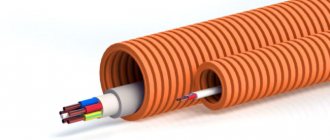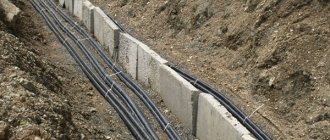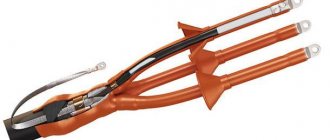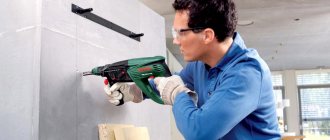Installation of cable lines is one of the services of our company in Moscow and the Moscow region. The work is carried out in strict adherence to all rules and regulations. For installation and laying of cable lines, it is necessary to use specialized equipment that is suitable in terms of parameters for the complexity and volume of work. Before the start, design documentation must be generated, which is agreed upon with all kinds of authorities responsible for power supply. Our specialists also do this. The documents specify technical aspects and the most suitable transportation methods. The prepared completed project serves as the basis for calculating the final price for installing cable lines.
Cost of installation and laying of lines
| Type of work: | Unit of measurement: | Price: |
| Line AVVBshV, armored, PVC insulation with a section of 4x25 in the ground, trench | m. | 700 rub. |
| Line AVVBshV, armored, PVC insulation with a cross-section of 4x240 in the ground, trench | m. | 1700 rub. |
| Line VVGng, PUgV with a section of 4x16 in trays | m. | 150 rub. |
| Line VVGng, PUgV with a section of 4x35 in trays | m. | 250 rub. |
| AVVBshV line with a cross-section of 4*50 in a pipe, using HDD, puncture under the road | m. | 4000 rub. |
| AVVBshV line with a cross-section of 4*240 in a pipe, using HDD, puncture under the road | m. | from 3000 rub. |
View full price
Cable line design
When designing cable lines, it is necessary to take into account the features of the network, the characteristics of the relief, the results of geodetic studies, the conditions for their further use and much more. Designers must receive a clear technical specification containing the wishes of the customer and the requirements for the project of land owners. As a result, the Customer receives a package of documents, which includes: a single-line diagram of the electrical network, diagrams of the intersection of the line with engineering systems, a route plan on the required scale, an explanatory note from the designers, and a situational plan.
We prepare design and estimate documentation and the entire range of works, allowing the customer to significantly reduce the cost of providing electricity to their facility. The costs of laying power cables are based on project cost calculations. The calculation also includes the collection and generation of permits for all types of work, excavation work, the cost of the cable, the cost of geodetic work and construction of the cable line. Next, all work related to laying, protecting and covering cable networks from possible accidental damage is taken into account. It is important to carefully consider the calculations for landscaping the surrounding area and restoring the removed coatings during the work.
By contacting our specialists, you can not only competently carry out all stages of work on laying cable lines in Moscow, but also save a lot of money on obtaining permits, conducting laboratory tests, etc.
Installation and laying of cable lines
There is a set of methods for installing cable lines:
- Pulling along the external walls of houses, structures and buildings;
- Hidden installation inside buildings and structures;
- Pulling in tunnels;
- Installation in ditches, trenches and other underground areas.
Hidden or open installation is carried out inside buildings, houses and structures. In the second case, the cable is attached to the ceiling and walls. When closed, installation is carried out in the floor, foundation, inside the walls, where cable channels are cut out.
External installation involves fixing the cable to the facade of buildings or prepared supports. The outer gasket can also be closed or open.
For underground installation, the manual method or cable laying method is used. The technique is necessary for laying at a specific depth. For shallow trenches, special equipment is not used.
Installation of cable lines in a building or in the ground by any method requires compliance with the standards and procedures for carrying out installation work. It is better to entrust all this to qualified specialists who are ready for any difficulties. To submit an application, contact us by phone.
Laying cables in the ground
For external cable laying, a cable of the appropriate cross-section is selected based on the expected loads and power consumption of electricity. In a project for the power supply of a structure, a special section describes in detail the steps for laying the power cable.
Laying a power cable is a separate type of work with clearly defined regulations for each stage. The depth of the trench must be more than 70 cm. When laying several cables in one trench, a distance of 10 cm must be provided between them. If it is technologically necessary to lay the cable in a shallower trench, special protection is developed to prevent mechanical damage.
The route design is developed based on the shortest distance between connection objects, taking into account the best conditions for cable safety. When developing a route, designers take into account environmental conditions and the presence of other technical networks. It must be taken into account that in one trench there cannot be more than six cables with a voltage of up to 10 kW, and no more than two cables with a voltage of up to 35 kW.
Work on laying the power cable must be carried out by organizations that have the appropriate approvals and permits. Our company's employees have all the necessary permits.
Laying in the ground
To install cable lines in the ground, it is necessary to form a network of pits and trenches of a given depth and depth. According to the standards of PUE and SNiP, laying in the ground is carried out at a depth of 70 cm or more. In places where there is an intersection with the roadway, the minimum depth requirement is already changing, so the value increases to a meter.
To prevent the cable line from being damaged, the cable is pulled in a pipe, which is laid in a sandy layer inside a trench or ditch. Next, a mesh is applied for protection. And then you can cover everything with earth.
Laying lines in tunnels
If there are a large number of buildings or underground engineering structures, as well as with a concentration of large industrial enterprises, installation of cable lines is carried out through tunnels.
There are 2 types of tunnels: round and rectangular tunnels. The round tunnels have a diameter of 2.6 m. Cables are laid in them on both sides. In tunnels with a rectangular cross-section, two-sided and one-sided laying of electrical lines is possible.
A special cable is used, according to the standards intended for installation in such communications. Provide measures to prevent the ingress of groundwater and wastewater and ensure fire safety. The tunnel type of installation is more expensive than others, but is also used often, since it is not possible to use another type of wiring.
Any type of installation of cable lines is always carried out taking into account all the rules and regulations established by law and must be carried out by experienced specialists. The specified work can be performed by GORINKOM , performing high-quality, competent installation of electrical lines at your facility.
VIDEO: watch how the construction of cable lines is done.
External gasket
This installation method is applicable when connecting facade lighting, signs, illuminated signs, surveillance cameras, connecting a cottage to the electrical network, a garage and other utility rooms. When carrying out external installation, it is important to strictly monitor compliance with the requirements of the PUE.
Protection of the cable from damage of a mechanical nature, as well as the formation of a more aesthetic appearance, is ensured by installing the cable in a corrugated pipe or electrical box made of metal. The corrugation is attached to the wall using staples or clips.
Cable laying methods
Several cable routing methods are used:
- Outer. The wires are attached to the wall using brackets and clips;
- Hidden. In order to lay the cable, it is necessary to groove the walls. The width and depth of the cut depends on the cross-section and dimensions of the wires installed in the wall;
- Laying the cable in the cable channel. There are boxes with opening lids and tightly sealed. It is possible to aesthetically join the elements of the box using special corners, tees and plugs. The size of the cable channel is determined by the number of wires laid in it;
- Underground. The cable is laid in a cable duct located underground or buried.
Cable laying can be done in two ways:
- Hidden: the cable runs inside structures: walls, ceilings, floors, between floors. It is possible to use cavities in some other types of structures and partitions. For example, the space between metal profiles is used.
- Open: wires are laid in a plastic cable channel, special channels inside baseboards, a corrugated pipe or a special roller insulator.
The choice of cable laying method depends on the type of electrical wiring, the material of construction of the facility, and especially on the category of the room and its purpose.
Technologies for laying cable lines
Electrical wires are laid at objects of varying complexity in the ground in prepared trenches or specialized structures: tunnels, channels, trays, boxes.
When laying them, adhere to the optimal method, taking into account the terrain and the following rules:
- for cities and towns, single cable lines are laid in the ground, in places where there is no busy traffic;
- the minimum distance between electrical wires in connecting trenches should not exceed 50 cm;
- no more than 6 cables can be placed in one trench;
- in busy areas it is necessary to lay cables in special pipes and blocks;
- if more than 20 cables are laid, tunnels must be used;
- if the laying of power cable lines is necessary in buildings, it can be carried out along building structures;
- in areas where utilities are concentrated, a line of 10 cables must be laid in a tunnel or collector;
- within large industrial facilities and power plants, cable lines are installed along overpasses, in tunnels, channels and blocks.
This task should only be performed by high-level specialists to ensure the reliability of the work performed. The electrical measuring laboratory "LABSIZ" in Moscow provides installation services and laying of cable lines. Before starting work, our engineers determine the location for laying the cable. To do this, it is necessary to analyze the characteristics of the soil, the presence of nearby communications, and the intersection of cable lines of utility structures. To do this, an assessment is carried out based on existing plans for power supply lines. After creating the project, it is sent for approval to local administrative authorities.
Laying (installation) of power cable
The power cable is an indispensable element that is always present in the electrical installation process. Therefore, every professional electrician knows how to lay (install) a power cable. The whole process, like others, is preceded by the development and approval of a project in which the type, cross-section of the cable, and method of its installation are determined.
There are several types and methods of laying (installing) power cables. These include cable laying in trenches, open and hidden laying inside buildings and structures, external cable laying
along the walls of buildings.
Underground laying of power cables involves manual or mechanized installation at a given depth using a cable laying machine. When using this method, pay attention to protecting the cable from various mechanical damage.
Open and hidden cable installation is carried out inside buildings. Open means laying cables over walls and ceilings, hidden means laying inside walls, foundations, floors, and in cable ducts.
External installation is the laying of power cables along the external walls of buildings or on supports. This type of installation is further divided into open and hidden.
More photos here
“Power supply for industrial buildings on a turnkey basis”
500 kW More details
“Laying the power cable in the tray. Installation of ASU 150 kW"
150 kW More details
Overhead line support
Overhead power lines and low-current networks are also installed on supports. Supports are classified by material and type.
Supports, pillars and masts of overhead cable lines according to material are divided into:
- wooden;
- reinforced concrete;
- metal.
Please note that according to regulations, metal supports are only allowed to be used in overhead cable lines with voltages over 1 kV.
Supports, pillars and masts of overhead cable lines are divided by type into:
- Intermediate. An intermediate support is a single pole that is placed in very long spans where the sagging of the cable under its own weight can pose a risk of breakage.
- Anchor. Installed on transitions, providing additional structural strength.
- Angular. They are installed at turns in the overhead cable line route, which prevents the formation of bends and kinks in the cable.
- A-shaped. Such supports are installed in places where wires are soldered to install arresters. A surge arrester is a device designed to limit overvoltages in electrical networks.
When laying overhead cable lines using supports, some temporary structures are allowed. An example is a hanging of non-galvanized single-core wires. Such wires are secured to supports on pin insulators using wire ties or special clamps. The connection of the wires can be anything - from thermite welding. The wires are connected with special connecting clamps, electric contact or thermite welding, depending on their type. Wires on high-voltage lines are usually aluminum, steel/aluminum or pure steel. They are secured to pin or suspension insulators (garlands) of overhead cable lines with supporting and tension locks.









